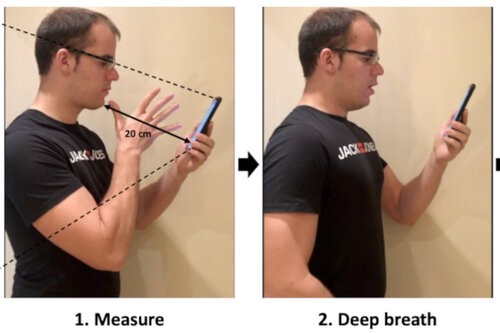First steps to determine lung age with a mobile phone
Research by UdL, CIMNE and IRBLleida that could help control chronic diseases
The mobile phone could be used as a type of spirometer - a device that measures lung capacity and helps to assess chronic diseases such as asthma, COPD or pulmonary fibrosis - offering a reliable alternative outside the hospital setting. This is the aim of research by the University of Lleida (UdL), the Biomedical Research Institute of Lleida (IRBLleida) and the International Centre for Numerical Methods in Engineering (CIMNE) that has just been published in the journal Sensors. The final milestone is to perfect a mobile application without additional hardware or external devices.
For the time being, the researchers at the UdL's Polytechnic School (EPS) have developed a machine learning model to obtain a person's lung age by analysing the properties of their expiration. They have chosen this parameter "to facilitate the interpretation of the results for people who are not clinical experts", instead of the usual measures of spirometry: forced vital capacity (FVC), forced expiratory volume in one second (FEV1) and peak expiratory flow (PEF).
The team has implemented a mobile application and an analogue website to record exhalations from 188 people, 91 men (48.4%) and 97 women (51.6%), aged between 17 and 67 years. The sampling records consisted of keeping a distance of approximately 20 centimetres between the mouth and the phone. The user then takes a deep breath and exhales as forcefully as possible for as long as possible, in line with traditional spirometry. For each sound sample, the researchers analysed 42 features.
Using this criteria, they tested different machine learning algorithms used in speech recognition. They found that using the linear quadratic discrimination algorithm and distributing people into age groups every 5 years, the accuracy of their model reached 94.69%, the sensitivity 94.45% and the specificity 99.45%. "The good results obtained show that it is possible to obtain the user's lung age by extracting the characteristics of an exhalation and that our methodology can become a reliable tool for use with mobile devices," says UdL PhD student Marc Pifarré.
As for the future, the goal of the UdL and IRBLleida researchers is to improve the current dataset of audio samples to improve results and reliability, as well as to further reduce the age range. "Our efforts are focused on providing easy-to-use and cheaper digital alternatives to spirometers that can be used by many more people around the world, anytime, anywhere," explain the authors. These devices "are mainly found in hospitals, limiting their use and, consequently, the monitoring of patients," adds IRBLleida researcher and former UdL professor Francesc Abella.
"It should be noted that this research also opens the door to other interesting and necessary applications in health, such as diagnosing the severity of tobacco consumption by measuring the levels of carbon monoxide (CO) in exhaled smoke," says Abella. The mobile application "could help monitor patients who want to quit smoking", he adds.
This research has been made possible thanks to funding from the Spanish Ministry of Science and Innovation (PID2020-113614RB-C22).
Information: UdL Press

Part of the measurement process shown in the 'Sensors' article / Photo: EPS-UdL






